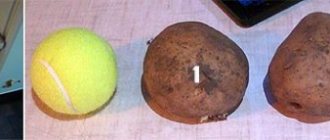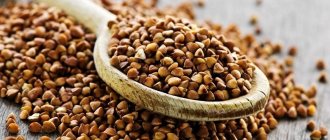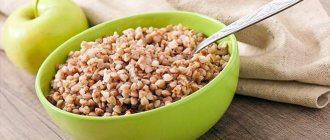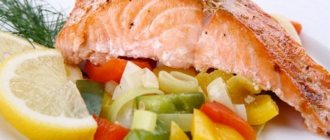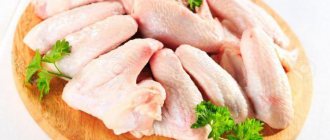Buckwheat is the most commonly used cereal due to its beneficial properties and high nutritional value. The last factor is directly related to calorie content, which varies depending on the method of preparation of the dish. Despite the fact that this figure is high, this product is in demand in weight loss diets. Thanks to slow carbohydrates and easily digestible proteins, buckwheat quickly and for a long time fills you up and energizes you.
Along with this, the body heals. Due to its great benefits and minimum contraindications, cereal is recommended for consumption by people of any age and condition.
Composition of buckwheat
Most often, buckwheat kernels are used for food - unsteamed and without husks, whole buckwheat grains of a rich brown color. This is the richest product in biochemical composition. It contains:
- starch;
- saturated and unsaturated fatty acids;
- mono- and disaccharides;
- vitamins: groups B, E, A, PP;
- micro- and macroelements: iron, phosphorus, magnesium, potassium, calcium, sodium, sulfur, silicon, iodine, zinc;
- organic acids: oxalic, citric, malic;
- arginine, lysine;
- routine;
- choline;
- folic and nicotinic acid;
- cellulose.
Benefits and composition of buckwheat
The chemical composition of the kernel is varied. It contains:
- beta-carotene;
- B vitamins (B1, B2, B5, B6, B9);
- vitamin E;
- vitamin PP,
- vitamin N.
Of the minerals necessary for normal functioning of the body, buckwheat contains:
- potassium;
- copper;
- magnesium and manganese;
- iodine;
- iron;
- zinc and selenium;
- fluorine and nickel;
- zinc and chlorine.
In addition to vitamins and minerals, cereals are rich in easily digestible protein of plant origin, which promotes hematopoiesis and increases the level of hemoglobin in the blood. Buckwheat porridge is recommended for use in case of kidney and liver diseases, a tendency to edema, diabetes mellitus, obesity, hypertension, atherosclerosis, etc. Regular consumption of buckwheat dishes increases the body's resistance to infectious diseases and reduces cholesterol levels. Buckwheat is allowed for diseases of the gastrointestinal tract and cardiovascular system.
Calorie content of buckwheat per 100 g
How many calories are in buckwheat depends on the type of grain and the method of heat treatment, as well as additional products used to prepare the dish. Dry buckwheat has a caloric content of 306 kcal per 100 g, so buckwheat is more caloric than rice (340 kcal), and it is also less caloric than corn grits (325 kcal), bulgur (342 kcal), spelt (336 kcal) or quinoa (368 kcal).
The calorie content of food buckwheat is usually lower (about 290 kcal), buckwheat has about 306 kcal, green groats - 308 kcal, and kernels - 313 kcal.
Calories and nutritional value
Buckwheat porridge is ideal for athletes and people watching their figure. Despite its nutritional value, it does not contribute to weight gain. It is a valuable source of vitamins and minerals.
Per 100 grams of dry grain there are 305 kcal with the following distribution of BJU: proteins - 14 g, fats - 4 g, carbohydrates - 60 g.
However, such a high indicator does not interfere with weight loss, since in the finished state the cereal is lower in calories. It’s easy to calculate how many calories are in one serving of buckwheat porridge yourself:
- Take the ratio of kernels and water 1:2 (for example, 100 g per 200 ml).
- After cooking, it swells, resulting in 300 g, while the total calorie content remains unchanged - 305 kcal.
- Divide this value by 3, so the energy value of 100 g is no more than 102 kcal.
The composition contains a predominance of carbohydrates, but they are complex and have a low glycemic index. Therefore, they are not forbidden to use without restrictions. That is why the product is indicated for mono-diets and fasting days.
Calorie content and nutritional value of all types of buckwheat per 100 g serving:
| Cooking method | Number of calories, kcal | Proteins, g | Fats, g | Carbohydrates, g |
| Boiled in water without salt and oil | 100,8 | 4,2 | 1,1 | 18,5 |
| On water, with oil | 137, 4 | 3,5 | 5,7 | 16,8 |
| With salt and butter | 142 | 4 | 2,6 | 16,6 |
| With salt and sunflower oil | 153,7 | 4,8 | 5,2 | 27,4 |
| With milk, no sugar or butter | 117,5 | 6,5 | 4,3 | 17,5 |
| With milk and sugar | 176 | 3,8 | 1,7 | 28,1 |
| With milk and butter | 177 | 6,2 | 7,1 | 21,8 |
| With meat (chicken, beef, turkey) | 117/108,6/105 | 10/6,7/9 | 2,4/4,4/2,8 | 13,8/11,3/11,5 |
| With kefir | 75,6 | 5,3 | 0,8 | 16,2 |
| Steamed | 108,2 | 4 | 1,5 | 20,8 |
As part of the dishes
The most accessible and common method of consumption is buckwheat porridge. Thanks to boiling, the amount of cereal increases, and the calorie content drops almost three times. But if, after boiling, it is added to a multi-component dish, then the nutritional value in most cases will become higher.
Cooked with stew
The simplest recipe for making stew with buckwheat: first fry the onion in the fat from the stew. Then add meat from the stew to the pan, then cereal, water and simmer until cooked. Bzhu 100 g dish:
- 10.2 g proteins;
- 6.6 g fat;
- 29.8 g carbohydrates.
Calorie content is 219.5 kcal. If you cook with beef stew, the nutritional value will be slightly lower. Standard portion (plate) - 250 g.
Cooked with milk
It is believed that cereals cooked with milk keep you feeling full for a long time and help reduce bad cholesterol in the body. Bzhu dish equals:
- 5.42 g protein;
- 3.37 g fat;
- 22.63 g carbohydrates.
Energy value - 139.62 kcal or 584 kJ.
Beneficial features
Buckwheat can be a complete substitute for meat, which is explained by its nutritional capabilities. Thanks to its rich chemical composition, it is able to saturate the human body with essential vitamins and microelements. It is recommended to include it in your daily diet to avoid many health problems.
Useful properties of buckwheat:
- Stabilizes blood pressure and hematopoiesis.
- Positively affects the musculoskeletal component.
- Activates the central nervous system and enhances brain activity.
- Serves as protection against malignant neoplasms.
- Prevents the development of cardiovascular diseases, strengthens vascular walls.
- Normalizes digestion: improves intestinal motility, relieves constipation.
- Increases immunity.
- Reduces “bad” cholesterol and hemoglobin levels in the blood.
- Cleanses away impurities and toxins.
- Uplifts your mood and energizes you.
- Helps eliminate swelling and inflammation due to arthrosis, arthritis and rheumatism.
Buckwheat dishes are recommended for constant consumption by children, which contributes to the normal development of the growing body. At the same time, mental abilities improve: concentration and memory. People involved in sports need such a nutritional supplement to gain muscle mass. This is due to the saturation of buckwheat with carbohydrates, which during the digestion process release a large supply of energy. Against this background, training is more productive.
For men, systematic consumption of buckwheat dishes will help in case of problems with potency and prevent inflammatory processes in the prostate gland.
Buckwheat is no less useful for women, as it improves appearance: it has a positive effect on the skin, structure of hair and nails. As a result, acne and irritation on the face disappear, and the skin becomes more elastic. Thanks to the cereal, hormonal levels return to normal, which is especially important during the onset of menopause and shortly before.
During pregnancy
During pregnancy, it is recommended to consume buckwheat regularly, as it is a valuable supplier of vital substances for both mother and child. Folic acid in its composition helps the proper development of the baby's central nervous system and prevents premature birth.
The high iron content makes cereal an indispensable remedy for the prevention of anemia. Its other components have a beneficial effect on the heart and blood vessels: they prevent varicose veins, control blood pressure, and protect against the development of atherosclerosis. It is impossible to gain weight on such dishes.
When breastfeeding, a woman should especially monitor her diet so as not to harm the baby. Eating buckwheat allows you to avoid many digestive problems in a newborn: bloating, colic and allergies.
When losing weight
Buckwheat is considered a dietary but nutritious product. Therefore, it is easy to lose weight on it, without the constant hunger inherent in many diets. Buckwheat dishes fill you up well and for a long time, which eliminates unnecessary snacks during the day. Despite the meager diet during such weight loss, the body does not experience much stress. This is due to the balanced and rich chemical composition of the cereal.
How many calories are in dry buckwheat?
The calorie content of buckwheat in dry form is 352 kcal. The energy value of buckwheat is practically not affected by its variety.
Interesting materials:
Where does the MTPL policy apply? Where does the law on self-employed people apply? Where do they obtain a work patent for a foreign citizen? Where is IP stamping done? Where do registrations for foreign citizens take place? Where do you get a visa to Finland? Where do temporary registrations for citizens of the Russian Federation take place? Where do they make a temporary one? Where to make an Inn for a child? Where to make cool presentations?
How to use
Eating buckwheat for weight loss will not bring the desired result if you combine it with certain foods:
- fat meat;
- sugar;
- smoked meats;
- sauces, mayonnaise;
- oil in large quantities.
It is advisable to eat any buckwheat dishes in the first half of the day. It is not forbidden to eat them in the evening, but no later than 18:00. You cannot eat buckwheat at night, as the product takes 1.5-2 hours to digest, which will not allow the digestive system to fully rest.
For fasting days, it is recommended not to cook the cereal, but to soak it. Then it retains more vitamins and microelements. To do this, you will need 200 ml of boiling water for 1 glass: steam it in a thermos in the evening and leave it overnight. In the morning, drain off the remaining liquid. There is no need to add salt or add anything. Divide the resulting dish into 5-6 servings and eat throughout the day.
If the bland taste of the porridge is unbearable, then you can add a little chopped herbs, kelp (seaweed) or a spoonful of honey.
With daily mental stress, such a poor diet can provoke increased cravings for sweets. Then you should mix porridge with dried fruits for breakfast, and drink a glass of honey water on an empty stomach every morning.
You can’t eat buckwheat alone for a long time, maximum 5–7 days. Otherwise, the body begins to lack minerals and other nutritional components. Therefore, they additionally eat fresh fruits and vegetables, eggs, sea fish, white meat and drink a lot. The result of losing weight in this way depends not only on the amount eaten, but also on optimal physical activity.
Buckwheat diet
The buckwheat diet is indicated not only for weight adjustment, but also in case of certain health problems. Cereals can be eaten in any form: boiled, steamed, soaked in kefir, baked. The menu for the day is varied, but within acceptable limits regarding the food set.
The advantage of such a diet is that buckwheat is allowed to be eaten in unlimited, but reasonable quantities. Because of this, those losing weight do not experience discomfort throughout the entire restrictive period. There is no need to count calories every day. In a week you can lose 7-8 kilograms while maintaining muscle mass.
The essence of the buckwheat diet:
- Eat 4-5 times in small portions. To avoid overeating, it is recommended to replace your usual plates with smaller ones, with a volume of 200–250 g.
- Drink up to 2 liters of water per day.
- Exclude from the diet foods and unhealthy drinks that are not included in the menu: store-bought juices, sweet soda, alcohol.
- Minimize salt intake.
- Stop eating 3 hours before bedtime.
Additional drinks: kefir (1% fat), still mineral water, green tea and herbal infusions. If you have an increased craving for sweets, then drink honey water: 1 tsp per glass. Suitable snacks include: green apples, oranges, grapefruit. You can eat no more than one fruit per day.
For the first 2–3 days, the basic dish is raw buckwheat porridge, then it is allowed to include various dietary recipes from cereals. Usually this regime is followed for a week, but if you are comfortable, it can be longer.
Options for light short-term buckwheat diets:
- Kefir. A fermented milk product is added to the classic version at the rate of 1 liter per day. They wash it down with porridge or put it directly into it.
- With fruits and vegetables . Any fruit except grapes, bananas, dates is mixed or eaten whole. Additionally include fresh or steamed non-starchy vegetables.
- Strengthening . The most varied nutritional option, where in addition to buckwheat it is acceptable to eat something else: cottage cheese for breakfast, veal and vegetable salad for lunch. Portions on this diet are larger, but the number of meals is reduced to 3.
If you eat only buckwheat, without salt and oil, then excess weight will go away very quickly. However, this is an emergency measure that will not bring health benefits.
What are the benefits of buckwheat?
Nutritionists, doctors and other specialists have long condemned the beneficial properties of buckwheat. There are also contraindications to its use, but there are many more beneficial properties. So, if you consume a lot of this cereal, gas formation and stimulation of peristalsis may occur.
But you can’t completely exclude buckwheat from your menu, because it has a beneficial effect on the body:
- Normalizes blood pressure
- Restores the strength of hair, nails and fights caries
- Helps improve mood
- Gets rid of extra pounds.
- Fights rheumatism, reducing joint pain
- Fights atherosclerosis, heartburn and skin diseases.
Buckwheat calorie table, per 100 grams of product
| Product | Calories, in kcal |
| calorie content of buckwheat boiled in water | 90,0 |
| calorie content of buckwheat boiled with milk | 102,0 |
| calorie content of buckwheat boiled with butter | 215,0 |
| calorie content of boiled buckwheat with mushrooms | 89,0 |
| calorie content of boiled buckwheat with vegetables | 390,0 |
| calorie content of boiled buckwheat with chicken | 48,0 |
Dietary recipes
Buckwheat can be prepared in different ways, all recipes are simple, with an affordable set of products. Dietary interpretations involve combination with mushrooms, vegetables, herbs, and lean meat.
For breakfast, they usually make milk porridge, replacing sugar with honey. It is undesirable to put a lot of butter, which significantly increases the calorie content. Diabetics are usually prescribed to mix porridge with kefir.
Casserole
Ingredients:
- buckwheat - 100 g;
- kefir - 100 ml;
- carrots - 1 pc.;
- chicken egg - 1 pc.;
- prunes - 3-4 pcs.;
- salt and spices - to taste.
Preparation:
- Pre-boil buckwheat and carrots.
- Mix the egg and kefir using a blender.
- Add dried fruits, cereals and grated carrots.
- Mix everything thoroughly and add some salt.
- Transfer to a heat-resistant form greased with olive oil.
- Bake at a temperature of +190°C for about half an hour.
Buckwheat soup
A light and nutritious soup that requires:
- chicken fillet (beef or veal) - 350–400 g;
- onion - 1 head;
- carrots - 1 pc.;
- celery - 1 stalk;
- buckwheat - 100 g;
- potatoes - 2–3 pcs.;
- vegetable oil - 20 ml;
- salt - to taste.
Cooking method:
- The meat is boiled in lightly salted water, which is then removed and cut into small pieces.
- Fry chopped carrots and onions in oil for 5 minutes.
- Add diced potatoes and cereal to the boiling broth.
- After 10–15 minutes, add the frying.
- 3-4 minutes before turning off, add chopped celery.
Calorie content of buckwheat dishes
From buckwheat you can prepare not only milk or dairy-free porridge, but also soups, desserts, pancakes, and pilafs. The calorie content of such dishes will be lower than when adding rice, millet or other cereals, and the taste will be brighter and richer. Yadritsa goes well with any meat, fish, spices, vegetables, fruits and dairy products. Its advantage is that the cereal cooks quickly, which means it will take a little time to prepare your favorite dish.
Meat buckwheat porridge
100 g of buckwheat with meat contains:
- 316 kcal;
- 10.5 g proteins;
- 18.6 g fat;
- 28 g carbohydrates.
To prepare 2 servings you need to take:
- 150 g kernels;
- 40 g olive oil;
- 100 g minced meat;
- 1 small onion;
- 1 small carrot.
Peel the onions and carrots, rinse and finely chop. Vegetables are fried in oil until golden brown, then minced meat is added to them. With constant stirring, fry for another 5-7 minutes. After this, add the washed buckwheat and add 2 cups of hot water. Cover with a lid and simmer over low heat until the cereal is ready. Before serving, season the dish with salt, spices and chopped fresh herbs.
Mushroom porridge with cabbage
Light dietary mushroom porridge contains in 100 g of the finished product:
- 192 kcal;
- 3.5 g proteins;
- 3 g fat;
- 12 g carbohydrates.
Ingredients:
- 150 g kernels;
- 300 g white cabbage;
- 300 g mushrooms;
- salt, curry, black pepper;
- vegetable oil for frying mushrooms.
Boil buckwheat porridge until half cooked. Finely chop the mushrooms and fry in vegetable oil. Chop the cabbage and add to the mushrooms. Simmer over medium heat for about 5 minutes. Add buckwheat porridge, spices and simmer covered over low heat until cooked.
Vegetable porridge
Buckwheat porridge with vegetables has a pleasant aroma and taste, as well as ease of preparation. This dish is well suited for dietary nutrition, because... it contains only (per 100 g):
- 178 kcal;
- 2.5 g proteins;
- 1.3 g fat;
- 14.5 g carbohydrates.
Ingredients:
- 1 cup kernels;
- 1 beet;
- 2 medium carrots;
- 1 onion;
- 1 tomato;
- 1 small sweet pepper;
- 1 young small zucchini;
- salt, black pepper, paprika, white pepper.
Rinse the buckwheat and pour boiling water over it for 2 hours, covering it with a lid and a towel. Grate carrots and beets on a medium grater. Cut the onion, pepper, tomato and zucchini into cubes and simmer for a few minutes in olive oil. Place all ingredients in a deep bowl with a thick bottom. Fill with water, add spices. Cook over low heat for about 30 minutes. Before serving, you can season with fresh herbs, a spoonful of sour cream or yogurt, and grated cheese.
Buckwheat porridge with stewed meat
A simple and beloved porridge that can be served with sour cream, fresh herbs, mushroom or spicy tomato sauce. Calorie content of buckwheat with stew:
- 220 kcal;
- 6 g proteins;
- 3.5 g carbohydrates;
- 18 g fat.
To prepare you need:
- 250 g stewed beef;
- 500 g kernels;
- 1 liter of water;
- salt, black pepper, curry.
Buckwheat is washed and boiled in salted water (about 25 minutes). Stew and spices are added to the finished porridge. Mix well. Before serving, season with fresh herbs.
Buckwheat porridge with beans
Nutritional value of the finished dish (per 100 g):
- 179 kcal;
- 3 g proteins;
- 1.3 g fat;
- 15 g carbohydrates.
Required Products:
- 1 cup kernels;
- 100 g green beans;
- 100 g carrots;
- 55 g onions;
- salt, black and white pepper.
Cut beans, carrots and onions into small cubes. Place in a thick-bottomed bowl. Sprinkle washed buckwheat on top. Add spices. Fill with hot water (you can use vegetable or chicken broth, 2 cups). Cover the bowl with a lid and cook over medium heat for about 30 minutes.
Soup with smoked meats
Savory and spicy soup will appeal to lovers of smoked meats and will also be a good addition to a quick and tasty lunch. 100 g of the finished dish contains:
- 160.5 kcal;
- 2.3 g protein;
- 2.5 g fat;
- 8 g carbohydrates
Ingredients:
- 2 liters of water;
- 250 g kernels;
- 150 g of smoked sausage (or chicken breast, turkey, you can use a mixture of smoked meats);
- 100 g sour cream;
- 1 onion;
- 1 clove of garlic;
- a little fresh dill;
- salt and black pepper.
Chop the onion and fry in butter along with buckwheat. Pour in water and cook over medium heat until the buckwheat is cooked. Cut the smoked meat into cubes and fry in a dry frying pan until golden brown. Wash and chop the dill. Pour the soup into bowls, add fried smoked meats, herbs, chopped garlic and sour cream to each bowl.
Meat soup with vegetables
Light and nutritious vegetable buckwheat soup is indispensable during diets and for healthy nutrition. Nutritional value of the dish (100 g):
- 242 kcal;
- 2.3 g protein;
- 1 g fat;
- 6.8 g carbohydrates.
Ingredients:
- 3 potato tubers;
- 1 medium carrot;
- 125 g veal;
- 1 tbsp. butter;
- 130 g kernels;
- 1 onion;
- salt, black pepper, bay leaf;
- fresh herbs for serving.
Cut the veal into small pieces and boil with spices in 1.5 liters of water. Strain the broth and boil. Add diced potatoes and carrots. Finely chop the onion and fry in butter until transparent. Add to broth. Cook for about 15 minutes. Wash the buckwheat and add it to the boiling broth. Cook for another 20-25 minutes with the lid closed. Sprinkle with fresh herbs before serving.
Pancakes
Fragrant buckwheat pancakes can be eaten with honey, sour cream, jam, fresh berries or fruits, as well as with cottage cheese, cheese or minced mushrooms. 100 g of the finished dish without additives contains:
- 153 kcal;
- 4 g proteins;
- 2 g fat;
- 17 g carbohydrates.
To prepare 20 thin pancakes you will need:
- 1 egg;
- buckwheat flour - 100 g;
- 0.5 glasses of milk;
- 1/2 tsp. soda;
- 1 tbsp. brown sugar;
- a pinch of salt;
- 2 tbsp. water;
- vegetable oil for frying.
Beat the egg with a whisk with milk and water. Add baking soda, salt and sugar while stirring constantly. Then add buckwheat flour in several stages. Stir and leave for 15-20 minutes. Fry the pancakes on both sides over low heat.
Buckwheat American pancakes
Fluffy and flavorful pancakes will be an excellent breakfast. You can serve them with any syrup, jam, sour cream, chocolate or cheese. 100 g of the finished dish without additives contains:
- 235 kcal;
- 3.5 g proteins;
- 9 g fat;
- 33 g carbohydrates.
To prepare you need:
- 250 ml milk;
- 120 g buckwheat flour (you can grind the buckwheat in a coffee grinder);
- 40 g whole grain or corn flour;
- 1 egg;
- 1 tsp baking powder;
- 2 tbsp. Sahara;
- 2 tbsp. butter;
- a pinch of salt.
Mix buckwheat and whole grain flour, sift, add sugar and baking powder. Mix the yolk with milk and carefully pour (with constant stirring) into the dry mixture. Add melted and cooled butter. Mix. Beat the whites with salt into a strong foam and add to the dough. Mix with a spatula from bottom to top. Place the dough by the tablespoon onto a well-heated frying pan. Fry on both sides until golden brown.
Beetroot and buckwheat brownie
Nutritional value of 100 g of finished product:
- 255 kcal;
- 8 g proteins;
- 7 g fat;
- 40 g carbohydrates.
Required ingredients:
- 2 tbsp. flax seeds;
- 6 tbsp. water;
- 1 tbsp. beet puree;
- 1.5 buckwheat flour;
- 0.5 cups dark honey;
- 0.5 cups cocoa without sugar;
- 1/2 tsp. salt;
- 1 tsp vanillin;
- 1/2 orange;
- 1/2 lemon;
- 0.5 cups chocolate chips.
Flax seeds are poured with water and left for 10-15 minutes to soak. Buckwheat flour is mixed with beet puree, flax seeds, cocoa, honey, salt, vanilla and grated (on a fine grater) orange and lemon zest. Knead the dough well. Then add chocolate chips and mix again. Preheat the oven to 200 °C. Cover the baking dish with baking paper and place the dough on top. Bake for about 30 minutes. The finished brownie is cut into portions and served with jam.
Buckwheat date cake
Nutritional value of 100 g of ready-made dish:
- 250 kcal;
- 7.5 g proteins;
- 12 g fat;
- 30 g carbohydrates.
To prepare a fragrant and unusual dessert, you need to take:
- 180 g almonds;
- 160 g dates;
- 250 g green buckwheat;
- 300 ml oat milk;
- 1 tsp chicory;
- 50 g grated dark chocolate.
70 g of dates are soaked in warm water for 20 minutes and pitted. Using a blender, grind almonds and dates, and place the resulting mass on the bottom of a baking dish. Green buckwheat crushed into flour is added to warm oat milk, then cooked until thickened over medium heat. The remaining dates are pitted and soaked in 50 ml of milk. The resulting buckwheat mass is beaten with dates and placed in a mold. Top with chocolate and chicory melted in a water bath. The resulting sweetness is placed in the refrigerator until completely hardened.
Carrot-buckwheat cutlets
Appetizing and rosy cutlets will be an excellent addition to lunch or a light dinner. They are quick and easy to prepare, and 100 g of product contains only:
- 195 kcal;
- 5.8 g protein;
- 4.5 g fat;
- 35 g carbohydrates.
To prepare this dish, you need to take:
- 1 cup kernels;
- 1 potato;
- 3 carrots;
- 1 tbsp. buckwheat flour;
- salt, black and white pepper;
- vegetable oil for frying.
Sort the buckwheat, rinse and boil until tender without salt. Grate the potatoes on a medium grater, and grate the carrots on a fine grater. Mix vegetables and porridge well and season with spices. Form small cutlets that are fried in hot oil.
Mushroom cutlets
Fragrant mushroom buckwheat cutlets can be served with a light sauce of yogurt or sour cream, fresh herbs, and steamed vegetables.
Calorie content of the dish (100 g):
- 174 kcal;
- 4 g proteins;
- 1.3 g fat;
- 12 g carbohydrates.
To prepare you need:
- 1 cup kernels;
- 300 g mushrooms;
- breadcrumbs;
- fresh herbs for serving;
- 1 medium onion;
- salt and black pepper.
Buckwheat is boiled without salt until cooked. Onions and mushrooms are cut into thin slices and sauteed in olive oil, after which they are crushed using a blender into minced meat. Mix mushroom mince and buckwheat porridge, add spices. If the mixture is very thick, add 1 egg white. Cutlets are formed from the resulting mass. Before frying, they can be rolled in breadcrumbs for a golden brown crust.
Curd and buckwheat casserole
Nutritional value of the finished dish (100 g):
- 165 kcal;
- 9 g proteins;
- 6 g fat;
- 20 g carbohydrates.
Products needed for cooking:
- 1.5 cups kernels;
- 250 g cottage cheese;
- 2 eggs;
- 3 tbsp. sour cream;
- 2 tbsp. Sahara;
- vanillin.
Beat the egg until foamy with a pinch of salt. Add sour cream and sugar and beat well with a mixer again. Leave a third of the mixture for pouring. Mix the prepared buckwheat with cottage cheese and rub through a sieve (you can turn it through a fine sieve in a meat grinder). Pour in the egg-sour cream mixture and mix thoroughly with a spatula. Place the resulting mass in a baking dish. Pour the remaining sour cream and egg mixture on top. Bake in the oven for about 25 minutes.
Buckwheat pilaf with Adyghe cheese
An unusual and tasty buckwheat recipe for vegetarians or fans of proper nutrition. This pilaf can also be prepared for those who are on a diet, because... it contains only (per 100 g):
- 155 kcal;
- 7.5 g proteins;
- 4.5 g fat;
- 20 g carbohydrates.
Ingredients:
- 200 g kernels;
- 150 g of Adyghe cheese;
- 1 carrot;
- salt, black pepper, nutmeg, cardamom, paprika, chili pepper, cumin;
- olive oil.
Cut the cheese into cubes. Grate the carrots on a coarse grater. Pour a little oil into a deep bowl with a thick bottom and add spices. When the oil is hot, add vegetables and cheese. Fry for 3-4 minutes with constant and gentle stirring. Add buckwheat and water, cover with a lid. Simmer for about 20 minutes over medium heat.
Buckwheat-mushroom pilaf
Calorie content of 1 serving of pilaf:
- 258 kcal;
- 17.7 g protein;
- 6.5 g fat;
- 33 g carbohydrates.
To prepare you need to take:
- 1 chicken fillet;
- 200 g kernels;
- 150 g mushrooms;
- vegetable oil;
- bay leaf, cumin, salt, black and white pepper, chili.
The buckwheat is washed, filled with water and boiled until tender. Wash the chicken fillet and cut into small pieces. Cut the mushrooms into thin slices. Fry mushrooms with chicken fillet in vegetable oil, season with spices. Add buckwheat porridge, a little water (1/2 cup) or broth. Close the lid and simmer over low heat for about 10 minutes. Before serving, season with fresh herbs.
Tips for cooking and using buckwheat and just interesting facts about porridge
- Buckwheat can be ground into flour. Buckwheat flour makes delicious pancakes, pancakes, pies, cakes, casseroles and even cakes. In Japan, this product is used to prepare Soba noodles, which is a traditional oriental dish.
- Buckwheat nectar is used to make honey.
- Buckwheat seedlings grow quite quickly, so buckwheat is harvested more often than others.
- Because buckwheat does not contain gluten, it can be consumed by people with gluten-related disorders (such as celiac disease, mild gluten sensitivity, or dermatitis herpetiformis).
- Japanese researchers say that 194 children out of 92,680 showed allergy symptoms in response to buckwheat. Please consult a specialist first before introducing this cereal into your baby’s diet.


